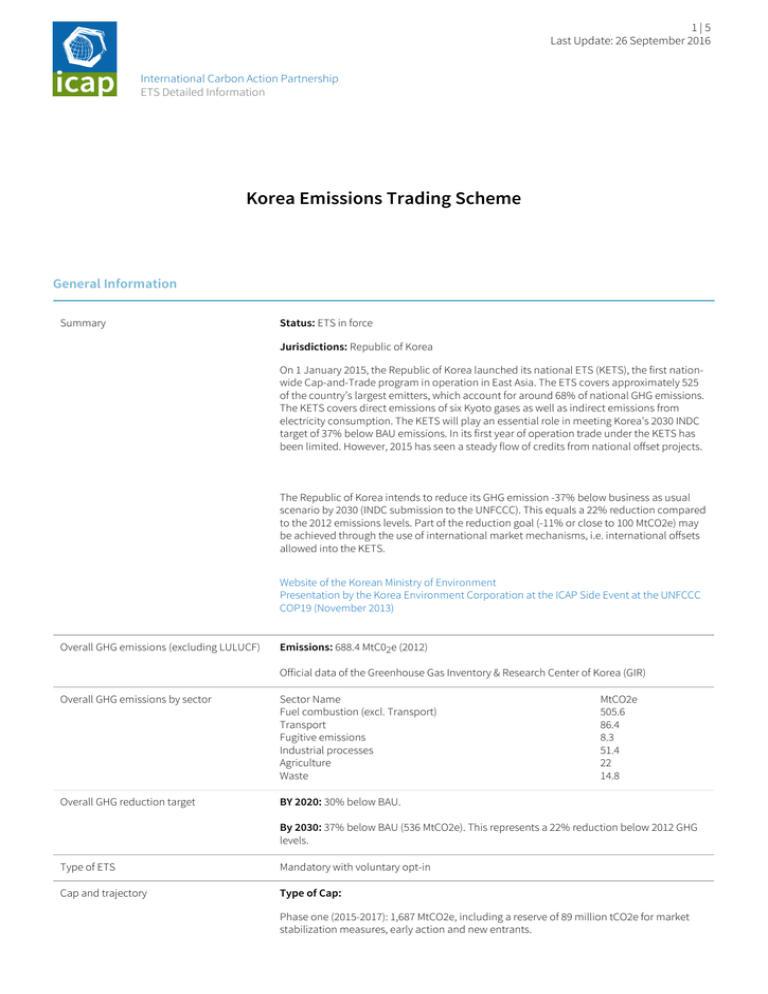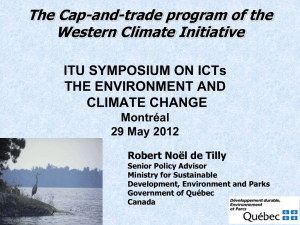
1|5
Last Update: 26 September 2016
International Carbon Action Partnership
ETS Detailed Information
Korea Emissions Trading Scheme
General Information
Summary
Status: ETS in force
Jurisdictions: Republic of Korea
On 1 January 2015, the Republic of Korea launched its national ETS (KETS), the first nationwide Cap-and-Trade program in operation in East Asia. The ETS covers approximately 525
of the country’s largest emitters, which account for around 68% of national GHG emissions.
The KETS covers direct emissions of six Kyoto gases as well as indirect emissions from
electricity consumption. The KETS will play an essential role in meeting Korea’s 2030 INDC
target of 37% below BAU emissions. In its first year of operation trade under the KETS has
been limited. However, 2015 has seen a steady flow of credits from national offset projects.
The Republic of Korea intends to reduce its GHG emission -37% below business as usual
scenario by 2030 (INDC submission to the UNFCCC). This equals a 22% reduction compared
to the 2012 emissions levels. Part of the reduction goal (-11% or close to 100 MtCO2e) may
be achieved through the use of international market mechanisms, i.e. international offsets
allowed into the KETS.
Website of the Korean Ministry of Environment
Presentation by the Korea Environment Corporation at the ICAP Side Event at the UNFCCC
COP19 (November 2013)
Overall GHG emissions (excluding LULUCF)
Emissions: 688.4 MtC02e (2012)
Official data of the Greenhouse Gas Inventory & Research Center of Korea (GIR)
Overall GHG emissions by sector
Sector Name
Fuel combustion (excl. Transport)
Transport
Fugitive emissions
Industrial processes
Agriculture
Waste
Overall GHG reduction target
BY 2020: 30% below BAU.
MtCO2e
505.6
86.4
8.3
51.4
22
14.8
By 2030: 37% below BAU (536 MtCO2e). This represents a 22% reduction below 2012 GHG
levels.
Type of ETS
Mandatory with voluntary opt-in
Cap and trajectory
Type of Cap:
Phase one (2015-2017): 1,687 MtCO2e, including a reserve of 89 million tCO2e for market
stabilization measures, early action and new entrants.
International Carbon Action Partnership
ETS Detailed Information
2|5
Last Update: 26 September 2016
2015: 573 MtCO2e
2016: 562 MtCO2e
2017: 551 MtCO2e
Caps for phase two and three have not yet been announced.
Carbon Price
Current Allowance Price (per t/CO2e): KRW 17,000 (approx. USD 14.34) (secondary market
price of 20 June 2016)
ETS Size
Emissions covered by the ETS
0.677
GHG covered
CO2, CH4, N2O, PFCs, HFCs, SF6
Sectors covered and thresholds
Phase one (2015-2017): 23 sub-sectors from steel, cement, petro-chemistry, refinery,
power, buildings, waste and aviation sectors.
Inclusion thresholds: company >125,000 tCO2/year, facility >25,000 tCO2/year
Number of liable entities
525 business entities including five domestic airlines.
Business entities eligible for the allocation of emissions allowances specified in the relevant
allocation plan under Article 5 (1) 3.
Point of regulation
Downstream
Phases & Allocation
Compliance period
One year
Trading period
Phase one: three years (2015-2017)
Phase two: three years (2018-2020)
Phase three: five years (2021-2025)
Allocation
Phase one (2015-2017): 100% free allocation, no auctioning.
Most sectors will receive free allowances based on the average GHG emissions of the base
year (2011-2013). Three sectors (grey clinker, oil refinery, aviation) will be allocated free
allowances following benchmarks based on previous activity data from the base year
(2011-2013).
During Phase one about 5% of total allowances are retained in a reserve for market
stabilization measures (14 MtCO2e), early action (41 MtCO2e), and other purposes including
new entrants (33 MtCO2e). In addition, any unallocated allowances and withdrawn
allowances will be transferred to the reserve.
Phase two (2018-2020):97% free allowances, 3% auctioned.
Phase three (2021-2025):less than 90% free allowances, more than 10% auctioned.
Energy-intensive and trade-exposed (EITE) sectors will receive 100% of their allowances for
free in all phases. EITE sectors are defined along the following criteria:
1. additional production cost of >5% and trade intensity of >10%; or
2. additional production cost of >30%; or
3. trade intensity of >30%
International Carbon Action Partnership
ETS Detailed Information
3|5
Last Update: 26 September 2016
Flexibility
Banking and borrowing
Banking is allowed without any restrictions. Borrowing is allowed only within a single
trading phase (maximum of 10% of entity's obligation), not across phases.
Offsets and credits
Phase one (2015-2017) and Phase two (2018-2020):
Qualitative limit: Only domestic credits from external reduction activities implemented
by non-ETS entities - and that meet international standards - may be used for compliance.
Domestic CDM credits (CERs) are allowed in the scheme. Eligible activities include those
eligible under the CDM and Carbon Capture and Storage (CCS). However, only activities
implemented after 14 April 2010 are eligible.
Quantitative limit:Up to 10% of each entity's compliance obligation.
Provisions for price management
Phase three (2021-2025): Up to 10% of each entity's compliance obligation with a
maximum
of 5%
coming from
offsets. market stabilization measures in the
The Allocation
Committee
mayinternational
decide to implement
following cases:
1. The market allowance price of six consecutive months is at least three times higher than
the average price of the two previous years.
2. The market allowance price of the last month is at least twice the average price of two
previous years and the average trading volume of the last month is at least twice the
volume of the same month of the two previous years.
3. The average market allowance price of a given month is smaller than 40% of the average
price of the two previous years.
In 2015 and 2016, the price threshold is KRW 10,000 (EUR 7).
The stabilization measures may include:
1. Additional allocation from the reserve (up to 25%)
2. Establishment of an allowance retention limit: minimum (70%) or maximum (150%) of
the allowance of the compliance year.
3. An increase or decrease of the borrowing limit (currently up to 10%).
4. An increase or decrease of the offsets limit (currently up to 10%).
5. Temporary set-up of a price ceiling or price floor.
Compliance
Monitoring, Reporting, Verification (MRV)
Reporting Frequency:Annual reporting of emissions must be submitted within three
months from the end of a given compliance year (by the end of March).
Verification: Emissions must be verified by a third-party verifier.
Other: Emissions reports are reviewed and certified by the Certification Committee of the
Ministry of Environment within five months from the end of a given compliance year (by the
end of May).
If the liable entity fails to report emissions correctly, the report will be disqualified.
Enforcement
The penalty shall not exceed three times the average market price of allowances of the
given compliance year or KRW 100,000/ton (EUR 70).
Other Information
Institutions involved
On 26 February 2016, it was announced that responsibility for the Korean Emissions
Trading Scheme (KETS) would move from the Ministry of Environment to the Ministry of
International Carbon Action Partnership
ETS Detailed Information
4|5
Last Update: 26 September 2016
Strategy and Finance. Additionally, the Prime Minister’s Office would take a more active
role in the operation of the KETS.
Linkage with other schemes
No information available yet.
International Carbon Action Partnership
ETS Detailed Information
5|5
Last Update: 26 September 2016
Disclaimer
Copyright © 2012 by International Carbon Action Partnership (ICAP). All rights reserved. The content provided by the ICAP ETS map is
protected by copyright. You are authorized to view, download, print and distribute the copyrighted content from this website subject to
the following condition: Any reproduction, in full or in part, must credit the International Carbon Action Partnership (ICAP) must include a
copyright notice. If you have any questions please contact info@icapcarbonaction.com. Developed and designed by Lucid.Berlin
The initial data as of December 2012 was compiled by the ICAP Secretariat for ICAP jurisdictions and by Ecofys for non-ICAP jurisdictions.
Since then, the ICAP Secretariat has continuously updated the data for the ICAP and non-ICAP jurisdictions. Information compiled in the
ICAP ETS Map is based on official and public information, as much as possible, and focuses on cap-and-trade systems for greenhouse gas
emissions. The ETS map thus does not aspire to monitor all climate policy instruments. This website presents interim results of a continuous
working process. Although the information contained therein is assembled with utmost care, ICAP and Ecofys cannot be held liable for the
timeliness, correctness and completeness of the information provided.
Please refer to the imprint on the website of the International Carbon Action Partnership regarding links to external websites, liability and
privacy policy.




